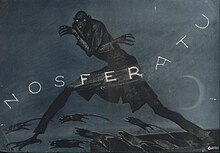Our website is made possible by displaying online advertisements to our visitors.
Please consider supporting us by disabling your ad blocker.
Nosferatu
| Nosferatu: A Symphony of Horror | |
|---|---|
 German magazine ad | |
| Directed by | F. W. Murnau[1] |
| Screenplay by | Henrik Galeen |
| Based on | Dracula by Bram Stoker |
| Produced by |
|
| Starring | |
| Cinematography |
|
| Music by | Hans Erdmann (1922 premiere)[1] |
Production company | Prana Film |
| Distributed by | Film Arts Guild |
Release date |
|
Running time | 63–94 minutes, depending on version and transfer speed[1] |
| Country | Germany |
| Languages |
|
Nosferatu: A Symphony of Horror (German: Nosferatu – Eine Symphonie des Grauens) is a 1922 silent German Expressionist vampire film directed by F. W. Murnau and starring Max Schreck as Count Orlok, a vampire who preys on the wife (Greta Schröder) of his estate agent (Gustav von Wangenheim) and brings the plague to their town.
Nosferatu was produced by Prana Film and is an unauthorized and unofficial knockoff of Bram Stoker's 1897 novel Dracula. Various names and other details were changed from the novel, including Count Dracula being renamed Count Orlok then finally Nosferatu, an archaic Romanian word with a suggested etymology of Nesuferitu`, meaning "the offensive one" or "the insufferable one". Although those changes are often represented as a defense against copyright infringement,[3] the original German intertitles acknowledged Dracula as the source. Film historian David Kalat states in his commentary track that since the film was "a low-budget film made by Germans for German audiences... setting it in Germany with German-named characters makes the story more tangible and immediate for German-speaking viewers".[4]
Even with several details altered, Stoker's heirs sued over the adaptation, and a court ruling ordered all copies of the film to be destroyed. However, several prints of Nosferatu survived,[1] and the film came to be regarded as an influential masterpiece of cinema and the horror genre.[5][6] Critic and historian Kim Newman declared it as a film that set the template for the genre of horror film.[7]
- ^ a b c d "Nosferatu: History and Home Video Guide". Brenton Film. 18 November 2015.
- ^ "Nosferatu: History and Home Video Guide, Part 2: 1920s Screenings". Brenton Film. 30 November 2016.
- ^ "All copies of the cult classic "Nosferatu" were ordered to be destroyed". 5 April 2017.
- ^ Kalat, David (2013). Nosferatu (Blu-ray audio commentary to the film). Eureka Entertainment.
- ^ "The 100 Best Films Of World Cinema". Retrieved 2 December 2016.
- ^ "What's the Big Deal?: Nosferatu (1922) (archived October 13, 2011)". Archived from the original on 13 October 2011. Retrieved 2 December 2016.
- ^ Marriott & Newman 2018, p. 20.
Previous Page Next Page
نوسفيراتو (فيلم 1922) Arabic Nosferatu: Qorxu simfoniyası AZ Насферату: Сімфонія жаху BE Насфэрату: Сымфонія вусьцішы BE-X-OLD Носферату – симфония на ужаса Bulgarian Nosferatu BS Nosferatu, Eine Symphonie des Grauens Catalan Upír Nosferatu (film, 1922) Czech Nosferatu Danish Nosferatu – Eine Symphonie des Grauens German


